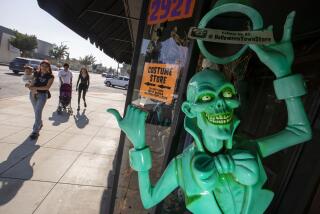Professor gives a short primer in time for the night of the living dead
- Share via
This is the time of year when the wisdom of Harry A. Senn is likely to make a public appearance, along with witches, vampires and werewolves.
The Pitzer College professor is an authority on otherworld phenomena associated with Halloween, and once people catch onto this, they come to him for explanations.
Senn is happy to oblige, even though the subject of mystical, mythical creatures requires that he defy the logic and reason that enable people to become college professors in the first place.
Readers of the many articles written by and about Senn may also find that they have to abandon logic and reason if they are ever going to learn why werewolves, witches, vampires and the like crop up in the “enlightened” Western world.
Senn may not be able to fully explain why the kid next door arrives at night with bag in hand, wearing a black cape and fangs that drip blood, or why his sister the witch carries a broomstick.
But he knows that their mythical ancestors are rooted in European cultures and that, like the kids next door, the original demons are not all bad.
Senn, 45, an amiable scholar of French and folklore, has made several trips to Europe to study folklore, focusing on rural areas of Romania where tales of werewolves and witches are said to have originated and where many people believe such creatures are alive among them today.
These legends and beliefs in supernatural beings, Senn said, “help people, especially those in rural areas, to explain the world of humans, of nature and the ‘other world.’ All these beliefs fit into a whole scheme that balances natural and supernatural worlds.”
American dramatizations of Count Dracula and the spooky figures of folklore have made the mystical creatures “embodiments of absolute evil,” Senn said.
But in the peasant societies of Romania, “there is a whole corpus of belief about people who are destined to be werewolves and witches,” and they are not all bad--or all good, Senn said. The magical, mystical powers that are ascribed to them help people explain life.
According to folklore, there are live witches and dead witches. The latter sometimes are referred to as vampires and are considered the reanimated dead “who had magical powers in life but are unwilling to part with life and go to the ‘other side,’ ” Senn said.
“Witches and werewolves are said to be born with telltale signs and to have certain characteristics. They may be functioning members of their communities who can be identified, but they are not persecuted.”
Rather than superstition, Senn finds such thinking “a rationalized body of beliefs that maintains harmony in a village.”
And while that may not qualify as enlightened thinking to some Western minds, neither is it ignorance, Senn believes.
“I think we live in a very ignorant society,” he said. In contrast to rural Romanians’ open acceptance of the supernatural, he said, “we stop our conception of operational phenomena at the limits of our waking consciousness. We reject anything that is not scientifically explainable.”
As a result, he said, most people “suffer a certain spiritual deprivation” that seems to deny “that there is an inner world that is a source of wisdom and encouragement, that there are larger connections between people. We are not islands.”
As examples of these larger connections, Senn said he has found universal symbols--such as the mandala, the cross and the swastika, all of them linked to the sun--appearing in many cultures.
“That’s why I got into folklore,” he said. “It shows that we as human beings are related. This is not a well-studied area. There’s a lot of mystery and hysteria surrounding it.”
Mythology and legends, he believes, are a source of creativity, even of great artistry.
“It takes the sting from death,” Senn said. “It takes the sting out of life, too.”
More to Read
Sign up for Essential California
The most important California stories and recommendations in your inbox every morning.
You may occasionally receive promotional content from the Los Angeles Times.












